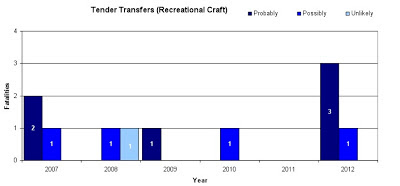Do you wear a lifejacket when you are transferring to a yacht by tender?
Wearing a lifejacket might have saved the lives of at least 4 people transferring to their boats using tenders in 2012. And in the last 6 years, at least 10 might have been saved if they had worn one.
So says an expert panel review comprising: Angling Trust, RNLI, Royal Yachting Association, Marine Accident Investigation Branch, Maritime and Coastguard Agency, National Water Safety Forum, British Canoe Union, the lifejacket industry, Scottish Fishermen’s Federation and University of Portsmouth.
 |
| All tender transfer fatalities where it was ‘possible’, ‘probable’ or ‘unlikely’ that a life may have been saved by correct lifejacket wear (2007 to 2012) |
Of the 4 incidents reviewed in 2012 all the tenders capsized. In one incident in February, a man was going out to his boat moored offshore to travel to a friend’s vessel which was having engine trouble. He was on his own in his rowing boat when the vessel capsized. Despite an extensive search he was not found – divers later located his body. He might have survived had he been wearing a lifejacket which would have kept him afloat and his head out of the water, even if he had been unconscious.
Most sailors and motor boaters recognise the importance of wearing a lifejacket or buoyancy aid when they are onboard their boats. But do you wear one when you are transferring to your vessel in a tender?
Who has compiled these statistics?
The panel compiling these statistics uses data supplied from Coastguard and MAIB databases and therefore only covers coastal incidents. Other inland tender transfer incidents, where a lifejacket might have saved a life may have occurred during 2012, but these are not included for this exercise.
In March 2013 the panel reviewed the Coastguard/MAIB data and assessed whether a lifejacket or buoyancy aid would have made a difference in saving a person’s life. A decision was made about whether it was probable, possible or unlikely that the person would have been saved by wearing a lifejacket or buoyancy aid. The panel also took into consideration factors such as whether the lifejacket or buoyancy aid was suitably maintained, correctly worn and fit for purpose. In some cases it was not appropriate for the person to be wearing a lifejacket or buoyancy aid, for example swimmers, and this was recorded.
Overall the Maritime and Coastguard Agency (MCA) recorded 132 maritime fatalities in 2012. The expert panel reviewed 45 fatalities where the casualty might have worn a lifejacket or buoyancy aid (so cliff fallers, suicides and so on were not included).
Of the 45 fatalities, the panel judged that it may have been appropriate for 27 people to have been wearing a lifejacket or buoyancy aid. Of these 27, the panel agreed that 20 would probably or could possibly have been saved had they been wearing a lifejacket or buoyancy aid.
In Australia all occupants of a vessel being used as a tender are required to wear a lifejacket while the tender is more than 200m from the nearest shore unless it is night time, they are alone or they are on open waters. In any of these situations they must wear a lifejacket irrespective of the distance from the shore.


Always!
And especially, doubly, always at night!
It has always been one of the commonest death scenarios among yachties.
Yes!
Also, whenever one leaves her/his home, s/he must wear: helmet, kneecaps, gloves, protective goggles, first-aid kit. 000s of lives would be saved!
Actually, one should wear that staff inside as well. 000s more lives would be saved each year!